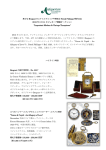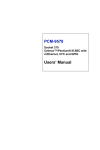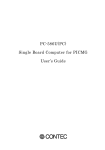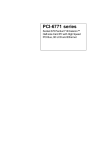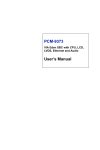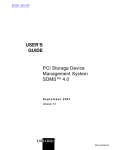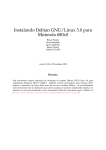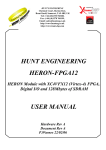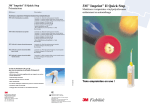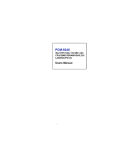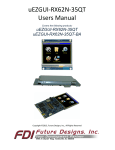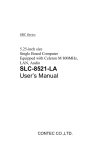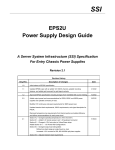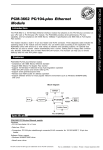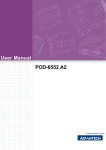Download PCM9570-S of manual
Transcript
PCM-9570/S Socket 370 Celeron™/Pentium® III SBC with LCD, Ethernet and SCSI User's Manual Copyright notice This document is copyrighted, 2000. All rights are reserved. The original manufacturer reserves the right to make improvements to the products described in this manual at any time without notice. No part of this manual may be reproduced, copied, translated or transmitted in any form or by any means without the prior written permission of the original manufacturer. Information provided in this manual is intended to be accurate and reliable. However, the original manufacturer assumes no responsibility for its use, or for any infringements upon the rights of third parties that may result from its use. Part No. 2006957005 Printed in Taiwan 4th Edition May 2000 Acknowledgments AMD is a trademark of Advanced Micro Devices, Inc. Award is a trademark of Award Software International, Inc. Cyrix is a trademark of Cyrix Corporation. IBM, PC/AT, PS/2 and VGA are trademarks of International Business Machines Corporation. Intel, Celeron, Pentium and Pentium II are trademarks of Intel Corporation. Microsoft Windows® is a registered trademark of Microsoft Corp. RTL is a trademark of Realtek Semi-Conductor Co., Ltd. Symbios is a trademark of Symbios Inc. Trident is a trademark of Trident Microsystems, Inc. UMC is a trademark of United Microelectronics Corporation. Windbond is a trademark of Winbond Electronics Corp. All other product names or trademarks are properties of their respective owners. For more information on this and other Advantech products please visit our websites at: http://www.advantech.com http://www.advantech.com/epc For technical support and service for please visit our support website at: http://support.advantech.com This manual is for the PCM-9570S Rev. B1. Packing list Before you begin installing your card, please make sure that the following materials have been shipped: • 1 PCM-9570/S all-in-one single board computer • 1 CD disc with utility and drivers • 1 Startup Manual If any of these items are missing or damaged, contact your distributor or sales representative immediately. Please refer to Appendix E for the optional interface wiring kit. Contents Chapter 1 General Information ....................... 1 1.1 1.2 1.3 1.4 Introduction ........................................................................2 Highly integrated Socket 370 SBC ......................................2 Features ...............................................................................3 Specifications ......................................................................3 Standard SBC functions .......................................................3 PCI SVGA/flat panel interface ............................................4 PCI bus Ethernet interface ...................................................5 Ultra2 SCSI (PCM-9570S only) ..........................................5 Solid state disk .....................................................................5 PanelLink (optional) ............................................................5 Mechanical and environmental ............................................5 Board layout and dimensions ............................................6 Chapter 2 Installation ....................................... 7 2.1 2.2 2.3 2.4 2.5 2.6 2.7 2.8 Jumpers ...............................................................................8 Connectors ..........................................................................9 Locating jumpers .............................................................10 Locating connectors .........................................................11 2.4.1 Component side ........................................................ 11 2.4.2 Solder side .................................................................12 Setting jumpers ................................................................13 CPU installation and upgrading .....................................14 2.6.1 Installing a CPU in the ZIF socket ............................14 2.6.2 CMOS clear (J1) ....................................................... 15 2.6.3 Buzzer enable/disable (J9) ........................................15 Installing DRAM (SODIMMs) .......................................16 2.7.1 Introduction ...............................................................16 2.7.2 Installing SODIMMs ................................................16 IDE hard drive connector (CN11) ..................................16 2.8.1 Connecting the hard drive .........................................17 2.9 2.10 2.11 2.12 2.13 2.14 2.15 2.16 2.17 2.18 2.19 2.20 2.21 2.22 2.23 Floppy drive connector (CN9) ........................................17 2.9.1 Connecting the floppy drive......................................18 Parallel port connector (CN12) .......................................18 Keyboard and PS/2 mouse connector (CN5) .................19 Front panel connector (CN18) ........................................19 2.12.1 Speaker ....................................................................19 2.12.2 LED interface ..........................................................19 2.12.3 Watchdog output .....................................................19 2.12.4 Reset switch ............................................................20 Power connectors (FAN1, CN14, CN6) ..........................20 2.13.1 Peripheral power connector, -5 V, -12 V (CN14) ...20 2.13.2 Main power connector, +5 V, +12 V (CN6) ...........20 2.13.3 Fan power supply connector (FAN1) .....................20 ATX power control connector (CN2, J4) .......................21 2.14.1 ATX feature connector (CN2) and power button (J4) .....................................................................................21 ATX power on function select (J11) ...............................22 IR connector (CN8) ..........................................................22 COM-port connector (CN20) ..........................................22 2.17.1 COM2 RS-232/422/485 setting (J10) .....................22 2.17.2 COM3/COM4 RI pin setting (J6) ...........................23 VGA interface connections ..............................................26 2.18.1 CRT display connector (CN15) ..............................26 2.18.2 Flat panel display connector (CN16) ......................26 2.18.3 Ext. flat panel display connector (CN17) ...............26 2.18.4 Panel type select (SW1) ..........................................27 Ethernet configuration ....................................................28 2.19.1 100Base-T connector (CN1) ...................................28 2.19.2 Network boot...........................................................28 2.19.3 LAN controller power select (J12) .........................28 Watchdog timer configuration .......................................29 2.20.1 Watchdog timer action (J2) .....................................29 USB connectors (CN19) ...................................................29 SCSI connectors (CN4) ....................................................30 PanelLink (CN22) (optional) ...........................................30 Chapter 3 Software Configuration ................ 31 3.1 3.2 Introduction ......................................................................32 Ethernet software configuration .....................................33 Chapter 4 Award BIOS Setup ........................ 35 4.1 4.2 System test and initialization .......................................... 36 4.1.1 System configuration verification .............................36 Award BIOS setup ...........................................................37 4.2.1 Entering setup ...........................................................37 4.2.2 Standard CMOS setup ...............................................38 4.2.3 BIOS features setup ..................................................39 4.2.4 Chipset features setup ...............................................40 4.2.5 Power management setup .........................................41 4.2.6 PnP/PCI configuration ..............................................42 4.2.7 Integrated peripherals ...............................................43 4.2.8 Load BIOS defaults ...................................................44 4.2.9 Change password ...................................................... 45 4.2.10 Auto detect hard disk ..............................................46 4.2.11 Save & exit setup ....................................................46 4.2.12 Exit without saving .................................................46 Chapter 5 PCI SVGA Setup ........................... 47 5.1 5.2 5.3 Introduction ......................................................................48 5.1.1 Chipset ......................................................................48 5.1.2 Display memory ........................................................ 48 5.1.3 Display types .............................................................48 5.1.4 Dual/simultaneous display ........................................49 Installation of SVGA driver ............................................ 50 5.2.1 Installation for Windows 95/98 ................................ 51 5.2.2 Installation for Windows NT ....................................54 Further information .........................................................57 Chapter 6 SCSI Setup and Configurations .. 59 6.1 6.2 6.3 6.4 6.5 6.6 6.7 6.8 Introduction ......................................................................60 Before you begin ...............................................................61 Basic rules for SCSI host adapter and device installation ........................................................................61 Configuring the SCSI adapter ........................................62 SCSI terminators .............................................................63 SDMS drivers ...................................................................64 Utility user's guide and installation instructions ..........65 Driver and utility installation .........................................67 Chapter 7 PCI Bus Ethernet Interface .......... 69 7.1 7.2 7.3 Introduction ......................................................................70 Installation of Ethernet driver ........................................70 7.2.1 Installation for MS-DOS and Windows 3.1 ..............70 7.2.2 Installation for Windows 95/98 ................................71 7.2.3 Installation for Windows NT ....................................73 Further information.........................................................75 Appendix A Programming the Watchdog Timer .......................................... 77 A.1 Programming the watchdog timer .................................78 Appendix B Installing PC/104 Modules ........ 81 B.1 Installing PC/104 modules ...............................................82 Appendix C Pin Assignments ....................... 85 C.1 C.2 C.3 C.4 C.5 C.6 C.7 Ethernet 10/100Base-T connector (CN1) .......................86 ATX power feature connector (CN2) .............................86 SCSI Connector (CN4) ....................................................87 Keyboard and PS/2 mouse connector (CN5) .................89 Main power connector (CN6) .........................................90 IR connector (CN8) ..........................................................90 Floppy drive connector (CN9) ........................................91 C.8 C.9 C.10 C.11 C.12 C.13 C.14 C.15 C.16 C.17 C.18 C.19 C.20 C.21 IDE hard drive connector (CN11) ..................................92 Parallel port connector (CN12) .......................................93 Backlight connector (CN13) ............................................ 94 Peripheral power connector (CN14) .............................. 94 CRT display connector (CN15) .......................................95 24-bit LCD display connector (CN16) ............................96 Ext. LCD display connector (CN17) ............................... 97 LCD signal mapping ........................................................ 98 Front panel connector (CN18) ........................................99 USB connectors (CN19) ...................................................99 COM port connector (CN20) ........................................100 CompactFlash card connector (CN21) .........................102 PanelLink connector (CN22).........................................103 Fan power connector (FAN1)........................................104 Appendix D System Assignments .............. 105 D.1 D.2 D.3 D.4 System I/O ports .............................................................106 1st MB memory map .....................................................107 DMA channel assignments ............................................107 IRQ mapping chart ........................................................108 Appendix E Optional Extras ........................ 109 E.1 E.2 E.3 E.4 PCM-10586-4 cable kit for PCM-9570/S .....................110 USB cable ........................................................................111 SCSI cables .....................................................................111 24-bit LCD cable adapter ..............................................111 Appendix F Mechanical Drawings .............. 113 F.1 F.2 Component side ..............................................................114 Solder side .......................................................................115 Tables Table 2-1: Jumpers .............................................................................. 8 Table 2-2: Connectors ......................................................................... 9 Table 2-3: CMOS clear (J1) ............................................................... 15 Table 2-4: Buzzer enable/disable (J9) ............................................... 15 Table 2-5: ATW power on function select (J11) ................................. 22 Table 2-6: COM2 RS-232/422/485 setting (J10) ................................ 23 Table 2-7: Serial port default settings ................................................ 23 Table 2-8: COM1 RI pin setting (J6) .................................................. 24 Table 2-9: COM2 RI pin setting (J6) .................................................. 24 Table 2-10: COM3 RI pin setting (J6) ................................................ 25 Table 2-11: COM4 RI pin setting (J6) ................................................ 25 Table 2-12: Panel type select (SW1) ................................................. 27 Table 2-13: LAN controller power select (J12) ................................... 28 Table 2-14: Watchdog timer action (J2) ............................................. 29 Table B-1: PC/104 connectors (CN10) .............................................. 84 Table C-1: Ethernet 10Base-T connector (CN1) ................................ 86 Table C-2: ATX power feature connector (CN2) ................................ 86 Table C-3: SCSI connector (CN4) ..................................................... 87 Table C-3: SCSI connector (CN4) [continued] ................................... 88 Table C-4: Keyboard and mouse connector (CN5) ............................ 89 Table C-5: Main power connector (CN6) ........................................... 90 Table C-6: IR connector (CN8) .......................................................... 90 Table C-7: Floppy drive connector (CN9) .......................................... 91 Table C-8: IDE hard drive connector (CN11) .................................... 92 Table C-9: Parallel port connector (CN12) ......................................... 93 Table C-10: Backlight connector (CN13) ........................................... 94 Table C-11: Peripheral power connector (CN14) ............................... 94 Table C-12: CRT display connector (CN15) ...................................... 95 Table C-13: 24-bit LCD display connector (CN16) ............................. 96 Table C-14: Ext. LCD display connector (CN17) ............................... 97 Table C-15: LCD signal mapping ....................................................... 98 Table C-16: Front panel connector (CN18) ........................................ 99 Table C-17: USB connectors (CN19) ................................................. 99 Table C-18: COM port connector (CN20) ........................................ 100 Table C-19: COM2 port for RS-232, RS-422 and RS-485 (CN20) ... 101 Table C-20: CompactFlash card connector (CN21) ......................... 102 Table C-21: PanelLink connector (CN22) ........................................ 103 Table C-22: Fan power connector (FAN1) ....................................... 104 Table D-1: System I/O ports ............................................................ 106 Table D-2: 1st MB memory map ...................................................... 107 Table D-3: DMA channel assignments ............................................ 107 Table D-4: IRQ mapping chart ......................................................... 108 Figures Figure 1-1: PCM-9570/S dimensions ................................................... 6 Figure 2-1: Locating jumpers ............................................................. 10 Figure 2-2: Locating connectors (component side) ............................ 11 Figure 2-3: Locating connectors (solder side) .................................... 12 Figure 2-4: Wiring for ATX power switch function .............................. 21 Figure 4-1: Setup program initial screen ............................................ 37 Figure 4-2: CMOS setup screen ........................................................ 38 Figure 4-3: BIOS features setup ........................................................ 39 Figure 4-4: Chipset features setup ..................................................... 40 Figure 4-5: Power management setup ............................................... 41 Figure 4-6: PnP/PCI configuration ..................................................... 42 Figure 4-7: Integrated peripherals ...................................................... 43 Figure 4-8: Load BIOS defaults ......................................................... 44 Figure 4-9: IDE HDD auto detection screen ....................................... 49 Figure 5-1: Selecting display settings ................................................ 77 Figure B-1: PC/104 module mounting diagram .................................. 83 Figure B-2: PC/104 module dimensions (mm) (±0.1) ......................... 83 Figure F-1: PCM-9570/S mechanical drawing - component side ..... 114 Figure F-2: PCM-9570/S mechanical drawing - solder side ............. 115 CHAPTER 1 General Information This chapter gives background information on the PCM-9570/S. Sections include: • Introduction • Features • Specifications • Board layout and dimensions 1.1 Introduction The PCM-9570/S is an all-in-one Celeron™/Pentium® III level single board computer (SBC) with an Ultra2 SCSI controller (PCM-9570S), a 2x AGP LCD controller, a PCI Fast Ethernet interface and one PCI expansion slot. With the Intel CeleronTM processor, the PCM-9570/S achieves outstanding performance that surpasses any other SBC in its class. This compact unit is only 203 x 146 mm (8" x 5.75"). It offers all the functions of a single board industrial computer, but still fits in the space of a 5.25" floppy drive. On-board features include four serial ports (three RS-232, one RS-232/422/485), one multi-mode parallel (ECP/EPP/SPP) port, two USB (Universal Serial Bus) ports, one infrared port (SIR), one CompactFlash socket for CFC, a floppy drive controller, and a keyboard/PS/2 mouse interface. The built-in high-speed PCI IDE controller supports PIO, UDMA/33 and bus master modes. Up to two IDE devices can be connected, including large hard disks, CD-ROM drives and tape backup drives. The PCM-9570/S features power management to minimize power consumption. It complies with the “Green Function” standard and supports doze, standby and suspend modes. In addition, the board’s watchdog timer can automatically reset the system or generate an interrupt in case the system stops due to a program bug or EMI. The PCM-9570/S has been certified as complying with FCC Class A and CE Marking Class A. Highly integrated Socket 370 SBC The PCM-9570/S is a highly integrated SBC that combines Ultra2 SCSI, PanelLink, and network functions on a single computer board the size of a 5.25" floppy drive. Major on-board devices adopt PCI technology to achieve outstanding computing performance when used with Intel® CeleronTM/Pentium® III processors, making the PCM-9570/S the world's smallest and most powerful all-in-one Socket 370 board. 2 PCM-9570/S User's Manual 1.2 Features • Ultra2 SCSI interface: Supports up to 80 MB/sec transfer rates (PCM-9570S only) • 3D VGA/LCD interface: Supports a 2x AGP interface, 3D 64-bit engine, as well as a 2.5 MB embedded Trident 9525 DVD chip • Display resolution: Up to 1024 x 768 @ 64 K colors, for both LCD and CRT displays • PanelLink (optional): Scalable bandwidth of 25 ~ 112 MHz (VGA 640 x 480 ~ SXGA 1280 x 1024) • 100 MHz FSB design: To facilitate future upgrading to Pentium® III • Wake on LAN; modem 1.3 Specifications Standard SBC functions • CPU: Socket 370 for Intel® CeleronTM processors up to 533 MHz or higher in the future (Rev. A); Socket 370 for Intel® Pentium® III processors up to 650 MHz or higher in the future (Rev. B) • BIOS: Award 256 KB Flash BIOS, supports Plug & Play, APM • Chipset: Intel 440BX • Green function: APM 1.1 compliant • 2nd level cache: 128 KB on the CeleronTM processor; 256 KB on the Pentium® III processor • RAM: Two 144-pin SODIMM sockets accept 8 ~ 256 MB SDRAM • Enhanced IDE interface: Primary channel for 2 IDE devices. Secondary channel for CompactFlash card • FDD interface: Supports up to two FDDs (360 KB/1.2 MB/ 720 KB/1.44 MB/2.88 MB) Chapter 1 General Information 3 • Serial ports: Four serial ports with +5 V / +12 V power capability (COM1, 3, 4: RS-232; and COM2: RS-232/422/485) • Watchdog timer: Software enabled/disabled. 62-level interval from 1 to 62 seconds. Jumperless selection. Generates system reset or IRQ11 • Keyboard/mouse connector: 8-pin header connector for keyboard and PS/2 mouse • USB interface: Two USB connectors with fuse protection. Complies with USB Spec. Rev. 1.0 • Infared port: Supports up to 115 Kbps transfer rates • PC/104 expansion: 104-pin 16-bit PC/104 module connector • I/O bus expansion: One 32-bit PCI bus expansion slot PCI SVGA/flat panel interface • Chipset: Trident Cyber 9525 DVD, high performance 64-bit GUI, 3D engine • Display memory: 2.5 MB of SDRAM frame buffer on cyber 9525DVD. 4 MB SDRAM frame buffer on Trident TM9540 (optional) • Display type: Simultaneously supports CRT and flat panel (EL, LCD and gas plasma) displays • Interface: 2x AGP, Accelerator Graphics Ports 1.0 compliant • Display mode: LCD panel supports up to 800 x 600 @ 24 bpp, 1024 x 768 @ 24 bpp. CRT displays support up to 800 x 600 @ 24 bpp, 1024 x 768 @ 24 bpp 4 PCM-9570/S User's Manual PCI bus Ethernet interface • Chipset: Realtek RTL8139 PCI-bus Ethernet controller • Ethernet interface: PCI 100/10 Mbps, IEEE 802.3U compatible • Remote boot ROM: For diskless system Ultra2 SCSI (PCM-9570S only) • Chipset: SYM 53C895 chips • Performance: Ultra2 SCSI interface, up to 80 MB/sec transfer rates Solid state disk • One 50-pin socket: For one CompactFlash card, shared with one IDE channel PanelLink (optional) • Chipset: Sil 154 Panel Link Digital Transmitter • Scalable band width: Ranging from 25 ~ 112 MHz (VGA ~ SXGA) • 24/48-bit one/two pixel per clock Mechanical and environmental • Power requirements: 5.2 A @ 5 V (4.75 to 5.25) (typical); 4.9 A @ 5 V with CeleronTM 466 and 128 MB SODIMM • Operating temperature: 0 ~ 60° C (32 ~ 140° F) • Size (L x W): 203 x 146 mm (8" x 5.75") • Weight: 0.32 kg (0.7 lb) Chapter 1 General Information 5 1.4 Board layout and dimensions Figure 1-1: PCM-9570/S dimensions 6 PCM-9570/S User's Manual CHAPTER 2 Installation This chapter tells how to set up the PCM-9570/S hardware, including instructions on setting jumpers and connecting peripherals, switches and indicators. Be sure to read all the safety precautions before you begin the installation procedure. 2.1 Jumpers The PCM-9570/S has a number of jumpers that allow you to configure your system to suit your application. The table below lists the function of each of the board’s jumpers: Table 2-1: Jumpers Label 8 Function J1 CMOS clear J2 Watchdog timer action J3 SCSI terminator power enable/disable J4 ATX power switch button J6 COM port RI pin setting J7 PanelLink control J9 Buzzer enable/disable J10 COM2 RS-232/422/485 setting J11 ATX power on function select J12 LAN controller power select SW1 Panel type select PCM-9570/S User's Manual 2.2 Connectors On-board connectors link the PCM-9570/S to external devices such as hard disk drives, a keyboard, or floppy drives. The table below lists the function of each of the board’s connectors: Table 2-2: Connectors Label Function CN1 Ethernet 100/10Base-T connector CN2 ATX feature connector CN4 SCSI connector CN5 Keyboard and PS/2 mouse connector CN6 Main power connector CN8 IR connector CN9 Floppy drive connector CN10 PC/104 ISA-bus expansion CN11 IDE hard drive connector CN12 Parallel port connector CN13 Backlight connector CN14 Peripheral power connector CN15 CRT display connector CN16 Flat panel connector CN17 Ext. flat panel display connector CN18 Front panel connector CN19 USB channel 1, 2 connector CN20 COM-port connector CN21 CFC connector CN22 PanelLink connector FAN1 Fan power connector Please refer to Appendix C for pin assignments. Chapter 2 Installation 9 2.3 Locating jumpers Figure 2-1: Locating jumpers 10 PCM-9570/S User's Manual 2.4 Locating connectors 2.4.1 Component side Figure 2-2: Locating connectors (component side) Chapter 2 Installation 11 2.4.2 Solder side Figure 2-3: Locating connectors (solder side) 12 PCM-9570/S User's Manual 2.5 Setting jumpers You configure your card to match the needs of your application by setting jumpers. A jumper is the simplest kind of electric switch. It consists of two metal pins and a small metal clip (often protected by a plastic cover) that slides over the pins to connect them. To “close” a jumper you connect the pins with the clip. To “open” a jumper you remove the clip. Sometimes a jumper will have three pins, labeled 1, 2, and 3. In this case you would connect either pins 1 and 2 or 2 and 3. 1 Open Closed 2 3 Closed 2-3 The jumper settings are schematically depicted in this manual as follows: 1 Open Closed Closed 2-3 A pair of needle-nose pliers may be helpful when working with jumpers. If you have any doubts about the best hardware configuration for your application, contact your local distributor or sales representative before you make any changes. Generally, you simply need a standard cable to make most connections. Chapter 2 Installation 13 2.6 CPU installation and upgrading You can upgrade to a higher power Pentium processor at any time. Simply remove the old CPU, install the new one, and set the jumpers for the new CPU type and speed. Warning! Always disconnect the power cord from your chassis when you are working on it. Do not make connections while the power is on as sensitive electronic components can be damaged by the sudden rush of power. Only experienced electronics personnel should open the PC chassis. Caution! Always ground yourself to remove any static charge before touching the PC board. Modern electronic devices are very sensitive to static electric charges. Use a grounding wrist strap at all times. Place all electronic components on a static-dissipative surface or in a static-shielded bag when they are not in the chassis. 2.6.1 Installing a CPU in the ZIF socket The PCM-9570/S provides a Zero Insertion Force (ZIF) socket for easy CPU installation. 1. Make sure the ZIF socket lever is in the upright position. To raise the lever, pull it out to the side a little and raise it as far as it will go. 2. Place the CPU in the empty socket. Follow the instructions that came with the CPU. If you have no instructions, do the following: Carefully align the CPU so it is parallel to the socket and the notch on the corner of the CPU corresponds with the notch on the inside of the socket. Gently slide the CPU in. It should insert easily. If it doesn‘t, pull the lever up a little more. 3. Press the lever down. The plate will slide forward. You will feel some resistance as the pressure starts to secure the CPU in the socket. This is normal and will not damage the CPU. 14 PCM-9570/S User's Manual When the CPU is installed, the lever should snap into place at the side of the socket. Note: To remove a CPU, pull the lever out to the side a little and raise it as far as it will go. Lift out the CPU chip. 2.6.2 CMOS clear (J1) Warning: To avoid damaging the computer, always turn off the power supply before setting “Clear CMOS.” Set the jumper back to “3V Battery On” before turning on the power supply. Table 2-3: CMOS clear (J1) * 3 V battery on 3 2 Clear CMOS 1 3 2 1 J1 * default setting 2.6.3 Buzzer enable/disable (J9) Table 2-4: Buzzer enable/disable (J9) * Enabled Disabled J9 * default setting Chapter 2 Installation 15 2.7 Installing DRAM (SODIMMs) 2.7.1 Introduction You can install anywhere from 16 MB to 128 MB of on-board DRAM memory using 16, 32, 64 or 128 MB 144-pin SODIMMs (Small Outline Dual In-Line Memory Modules). 2.7.2 Installing SODIMMs Note: The modules can only fit into a socket one way and their gold pins must point down into the SODIMM socket. The procedure for installing SODIMMs appears below. Please follow these steps carefully. 1. Ensure that all power supplies to the system are switched Off. 2. Install the SODIMM card. Install the SODIMM so that its gold pins point down into the SODIMM socket. 3. Slip the SODIMM into the socket at a 45 degree angle and carefully fit the bottom of the card against the connectors. 4. Gently push the SODIMM into a perpendicular position until the clips on the ends of the SODIMM sockets snap into place. 5. Check to ensure that the SODIMM is correctly seated and all connector contacts touch. The SODIMM should not move around in its socket. 2.8 IDE hard drive connector (CN11) You can attach one or two Enhanced Integrated Device Electronics hard disk drives to the PCM-9570/S’s internal controller. The PCM-9570/S’s IDE controller uses a PCI local-bus interface. This advanced IDE controller supports faster data transfer, PIO mode 3, mode 4. 16 PCM-9570/S User's Manual 2.8.1 Connecting the hard drive Connecting drives is done in a daisy-chain fashion and requires one of two cables (not included in this packing), depending on the drive size. 1.8" and 2.5" drives need a 1 x 44-pin to 2 x 44-pin flat-cable connector. 3.5" drives use a 1 x 44-pin to 2 x 40-pin connector. Wire number 1 on the cable is red or blue, and the other wires are gray. 1. Connect one end of the cable to CN11. Make sure that the red (or blue) wire corresponds to pin 1 on the connector, which is labeled on the board (on the right side). 2. Plug the other end of the cable to the Enhanced IDE hard drive, with pin 1 on the cable corresponding to pin 1 on the hard drive. (See your hard drive’s documentation for the location of the connector.) Connect a second drive as described above. Unlike floppy drives, IDE hard drives can connect to either end of the cable. If you install two drives, you will need to set one as the master and one as the slave by using jumpers on the drives. If you install just one drive, set it as the master. 2.9 Floppy drive connector (CN9) You can attach up to two floppy drives to the PCM-9570/S’s on-board controller. You can use any combination of 5.25” (360 KB and 1.2 MB) and/or 3.5” (720 KB, 1.44 MB, and 2.88 MB) drives. A 34-pin daisy-chain drive connector cable is required for a dual-drive system. On one end of the cable is a 34-pin flat-cable connector. On the other end are two sets of floppy disk drive connectors. Each set consists of a 34-pin flat-cable connector (usually used for 3.5” drives) and a printed-circuit board connector (usually used for 5.25” drives). Chapter 2 Installation 17 2.9.1 Connecting the floppy drive 1. Plug the 34-pin flat-cable connector into CN9. Make sure that the red wire corresponds to pin one on the connector. 2. Attach the appropriate connector on the other end of the cable to the floppy drive(s). You can use only one connector in the set. The set on the end (after the twist in the cable) connects to the A: drive. The set in the middle connects to the B: drive. 3. If you are connecting a 5¼” floppy drive, line up the slot in the printed circuit board with the blocked-off part of the cable connector. If you are connecting a 3½” floppy drive, you may have trouble determining which pin is pin number one. Look for a number printed on the circuit board indicating pin number one. In addition, the connector on the floppy drive connector may have a slot. When the slot is up, pin number one should be on the right. Check the documentation that came with the drive for more information. If you desire, connect the B: drive to the connectors in the middle of the cable as described above. If you need to make your own cable, you can find the pin assignments for the board’s connector in Appendix C. 2.10 Parallel port connector (CN12) Normally, the parallel port is used to connect the card to a printer. The PCM-9570/S includes a multi-mode (ECP/EPP/SPP) parallel port, accessed through CN12, a 26-pin flat-cable connector. You will need an adapter cable if you use a traditional DB-25 connector. The adapter cable has a 26-pin connector on one end and a DB-25 connector on the other. The parallel port is designated as LPT1 and can be disabled or changed to LPT2 or LPT3 in the system BIOS setup. The parallel port interrupt channel is designated to be IRQ7. You can select ECP/EPP DMA channel via BIOS setup. 18 PCM-9570/S User's Manual 2.11 Keyboard and PS/2 mouse connector (CN5) The PCM-9570/S board provides a keyboard connector that supports both a keyboard and a PS/2 style mouse. In most cases, especially in embedded applications, a keyboard is not used. The standard PC/AT BIOS will report an error or fail during power-on self-test (POST) after a reset if the keyboard is not present. The PCM-9570/S’s BIOS standard setup menu allows you to select “All, But Keyboard” under the “Halt On” selection. This allows no-keyboard operation in embedded system applications without the system halting under POST (power-on-self-test). 2.12 Front panel connector (CN18) Next, you may want to install external switches to monitor and control the PCM-9570/S. These features are optional - install them only if you need them. The front panel connector (CN18) is an 8-pin male, dual in-line header and provides connections for a speaker, hard disk access indicator, watchdog output and an input switch for resetting the card. 2.12.1 Speaker The PCM-9570/S can drive an 8 Ω speaker at 0.5 watts. Make sure that alternatives to this specification do not overload the card. 2.12.2 LED interface The front panel LED indicator for hard disk access is an active low signal (24 mA sink rate). 2.12.3 Watchdog output When PCM-9570/S watchdog timer times out, the front panel pin 6 will output an active low pulse signal (25mA sink rate for 1 second). Chapter 2 Installation 19 2.12.4 Reset switch If you install a reset switch, it should be an open single pole switch. Momentarily pressing the switch will activate a reset. The switch should be rated for 10 mA, 5 V. If you need to make your own cable, you can find the pin assignments for the board’s connector in Appendix C. 2.13 Power connectors (FAN1, CN14, CN6) 2.13.1 Peripheral power connector, -5 V, -12 V (CN14) Supplies secondary power to devices that require -5 V and -12 V. 2.13.2 Main power connector, +5 V, +12 V (CN6) Supplies main power to the PCM-9570/S (+5 V) and devices that require +12 V. 2.13.3 Fan power supply connector (FAN1) Provides power supply to optional CPU cooling fan. Only present when +5 V and +12 V power is supplied to the board. 20 PCM-9570/S User's Manual 2.14 ATX power control connector (CN2, J4) 2.14.1 ATX feature connector (CN2) and power button (J4) The PCM-9570/S can support an advanced power button if an ATX power supply is used. To enable the power button: 1. Take the specially designed ATX-to-PS/2 power cable (PCM-9570/S optional item). 2. Connect the 3-pin plug of the cable to CN2 (ATX feature connector). 3. Connect the power on/off button to J4. (A momentary type of button should be used.) Important: Be sure that the ATX power supply can take at least a 10 mA load on the 5 V standby lead (5VSB). If not, you may have difficulty powering on your system. Figure 2-4: Wiring for ATX power switch function Chapter 2 Installation 21 2.15 ATX power on function select (J11) Table 2-5: ATW power on function select (J11) Default on 3 J12 2 1 Default off * 3 2 1 * default setting Note1: J11 select 1-2, that while AC power is turned on, the system cannot boot up without ATX power switch button J4. Note2: J11 select 2-3, that while AC power is turned on, the cannot boot up without ATX power switch button J4. 2.16 IR connector (CN8) The PCM-9570/S provides an IrDA port for transfer rates of 115 Kbps. This connector supports the optional wireless infrared transmitting and receiving module. This module mounts on the system case. You must configure the setting through BIOS setup. 2.17 COM-port connector (CN20) The PCM-9570/S provides four serial ports (COM1, 3, 4: RS-232; COM2: RS-232/422/485) in one COM port connector. The COM port connector is a 40-pin, dual-in-line, male header and provides connections for serial devices (a mouse, etc.) or a communication network. You can find the pin assignments for the COM port connector in Appendix C. 2.17.1 COM2 RS-232/422/485 setting (J10) COM2 can be configured to operate in RS-232, RS-422, or RS-485 mode. This is done via J10. 22 PCM-9570/S User's Manual Table 2-6: COM2 RS-232/422/485 setting (J10) * RS-232 J10 RS-422 RS-485 18 17 18 17 18 17 14 13 14 13 14 13 10 9 10 9 10 9 6 5 6 5 6 5 2 1 2 1 2 1 * default setting The IRQ and the address range for COM1, 2, 3, 4 are fixed. However, if you wish to disable the port or change these parameters later you can do this in the system BIOS setup. The table below shows the settings for the PCM-9570/S’s serial ports. Table 2-7: Serial port default settings Port Address range Interrupt COM1 3F8 ~ 3FF IRQ4 COM2 2F8 ~ 2FF IRQ3 COM3 3E8 ~ 3EF IRQ10 COM4 2E8 ~ 2EF IRQ5 2.17.2 COM3/COM4 RI pin setting (J6) COM1 through COM4 can supply +5 V or +12 V power to the serial devices via the RI pin of the COM port connector. The outputs of the COM1 ~ COM4 RI pins are selected by setting J6. Chapter 2 Installation 23 Table 2-8: COM1 RI pin setting (J6) +5 V 1 23 2 24 J6 +12 V 1 3 23 2 4 24 J6 * RI (default setting) 1 5 23 2 6 24 J6 Table 2-9: COM2 RI pin setting (J6) +5 V 1 7 23 2 8 24 J6 +12 V 1 9 23 2 10 24 J6 * RI (default setting) 1 11 23 2 12 24 J6 24 PCM-9570/S User's Manual Table 2-10: COM3 RI pin setting (J6) +5 V 1 13 23 2 14 24 J6 +12 V 1 15 23 2 16 24 J6 * RI (default setting) 1 17 23 2 18 24 J6 Table 2-11: COM4 RI pin setting (J6) +5 V 1 19 23 2 20 24 J6 +12 V 1 21 23 2 22 24 J6 * RI (default setting) 1 23 2 24 J6 Chapter 2 Installation 25 2.18 VGA interface connections The PCM-9570/S’s PCI SVGA interface can drive conventional CRT displays and is capable of driving a wide range of flat panel displays, including electroluminescent (EL), gas plasma, passive LCD and active LCD displays. The board has two connectors to support these displays, one for standard CRT VGA monitors and one for flat panel displays. 2.18.1 CRT display connector (CN15) CN15 is a 16-pin, dual-in-line header used for conventional CRT displays. A simple one-to-one adapter can be used to match CN15 to a standard 15-pin D-SUB connector commonly used for VGA. Pin assignments for CRT display connector CN15 are detailed in Appendix C. 2.18.2 Flat panel display connector (CN16) CN16 is a 40-pin connector which can support a 24-bit TFT LCD. It is Hirose’s product no. DF13A-40DP-1.25V. The PCM-9570/S provides a bias control signal on CN16 that can be used to control the LCD bias voltage. It is recommended that the LCD bias voltage not be applied to the panel until the logic supply voltage (+5 V or +3.3 V) and panel video signals are stable. Under normal operation, the control signal (ENAVEE) is active high. When the PCM-9570/S’s power is applied, the control signal is low until just after the relevant flat panel signals are present. 2.18.3 Ext. flat panel display connector (CN17) CN17 consists of a 20-pin header, which is Hirose’s product no. DF13A-20DP-1.25V. The PCM-9570/S supports a 36-bit LCD panel with connections to both CN16 and CN17. For details of pin assignments, refer to Appendix C. 26 PCM-9570/S User's Manual 2.18.4 Panel type select (SW1) SW1 is a 6-pin dip switch for selecting the type of panel and display mode. Table 2-12: Panel type select (SW1) Panel type Pin 1 Pin 2 Pin 3 Pin 4 Pin 5 Pin 6 TFT 640 x 480 18-bit OFF ON ON ON ON - TFT 800 x 600 18-bit OFF OFF ON ON ON - TFT 1024 x 768 24-bit OFF ON OFF ON ON - TFT 1024 x 768 36-bit OFF OFF OFF ON ON - STN 640 x 480 16-bit OFF ON ON ON OFF - STN 800 x 600 16-bit OFF OFF ON ON OFF - STN 1024 x 768 16-bit OFF ON OFF ON OFF - STN 1024 x 768 24-bit OFF OFF OFF ON OFF - Default setting ON ON ON ON ON ON Note 1: If the Pin 1 of SW1 is in the ON position, the LCD is disconnected. Note 2: Pin 6 is reserved for PanelLink setting. Chapter 2 Installation 27 2.19 Ethernet configuration The PCM-9570/S is equipped with a high performance 32-bit PCI-bus Ethernet interface which is fully compliant with IEEE 802.3U 10/100Mbps CSMA/CD standards. It is supported by all major network operating systems. The medium type can be configured via the RSET8139.EXE program included on the utility disk. (See Chapter 3 for detailed information.) 2.19.1 100Base-T connector (CN1) 100Base-T connects to the PCM-9570/S via an adapter cable to a 10-pin polarized header (CN1). For 10Base-T RJ-45 operation, an adapter cable converting CN1 into a standard RJ-45 jack is required. 2.19.2 Network boot The Network Boot feature can be utilized by incorporating the Boot ROM image files for the appropriate network operating system. The Boot ROM BIOS files are on the included utility disk. 2.19.3 LAN controller power select (J12) Table 2-13: LAN controller power select (J12) +5 V* 3 2 Standby 5 V 1 3 2 1 *default setting Note: 28 PCM-9570/S supports wake-on LAN. For wake-on LAN, J12 has to select standby 5 V (2-3) position. PCM-9570/S User's Manual 2.20 Watchdog timer configuration An on-board watchdog timer reduces the chance of disruptions which EMP (electro-magnetic pulse) interference can cause. This is an invaluable protective device for standalone or unmanned applications. Setup involves one jumper and running the control software (refer to Appendix A). 2.20.1 Watchdog timer action (J2) When the watchdog timer activates (CPU processing has come to a halt), it can reset the system or generate an interrupt on IRQ11. This can be set via setting J2 as shown below: Table 2-14: Watchdog timer action (J2) * System reset 3 2 1 IRQ11 3 2 1 J2 * default setting 2.21 USB connectors (CN19) The PCM-9570/S board provides two USB (Universal Serial Bus) interfaces which gives complete plug and play, hot attach/detach for up to 127 external devices. The USB interfaces comply with USB specification rev. 1.0 and are fuse protected. The USB interfaces are accessed through two 4-pin flat-cable connectors, CN19. You will need an adapter cable if you use a standard USB connector. The adapter cable has a 4-pin connector on one end and an USB connector on the other. The USB interfaces can be disabled in the system BIOS setup. Chapter 2 Installation 29 2.22 SCSI connectors (CN4) The PCM-9570/S has a 68-pin D-sub connector for Ultra2 SCSI devices. Connection of SCSI devices requies special attention, especially when determining the last drive on the SCSI chain. Refer to Chapter 6 and your device’s operating manual for detailed installation information. 2.23 PanelLink (CN22) (optional) The PCM-9570/S optional PanelLink function uses Silicon Image Inc.’s Universal Transmitter SiI150 chip. It can support 25 ~ 112 MHz clock speeds, for VGA through to SXGA LCD panels. The 20-pin PanelLink transmitter connector is Hirose Electric Co., Ltd.’s product no. DF13A-20DP-1.25V. 30 PCM-9570/S User's Manual CHAPTER 3 Software Configuration This chapter details the software configuration information. It shows you how to configure the card to match your application requirements. AWARD System BIOS is covered in Chapter 4. Sections include: • Introduction • Ethernet interface configuration 3.1 Introduction The PCM-9570/S system BIOS and custom drivers are located in a 256 Kbyte, 32-pin (JEDEC spec.) Flash ROM device, designated U15. A single Flash chip holds the system BIOS, VGA BIOS, and network Boot ROM image. The display can be configured via CMOS settings. This method minimizes the number of chips and difficultly of configuration. To set different types of LCD panels please choose “panel type” from the “Intergrated Peripherals” menu in CMOS setup. 32 PCM-9570/S User's Manual 3.2 Ethernet software configuration The PCM-9570/S’s on-board Ethernet interface supports all major network operating systems. To configure the medium type, to view the current configuration, or to run diagnostics, do the following: 1. Power the PCM-9570/S on. Make sure that the RSET8139.EXE file is located in the working drive. 2. At the prompt, type RSET8139.EXE and press <Enter>. The Ethernet configuration program will then be displayed. 3. This simple screen shows all the available options for the Ethernet interface. Just highlight the option you wish to change by using the Up and Down keys. To change a selected item, press <Enter>, and a screen will appear with the available options. Highlight your option and press <Enter>. Each highlighted option has a helpful message guide displayed at the bottom of the screen for additional information. 4. After you have made your selections and are sure this is the configuration you want, press ESC. A prompt will appear asking if you want to save the configuration. Press Y if you want to save. The Ethernet Setup Menu also offers three very useful diagnostic functions. These are: 1. Run EEPROM test 2. Run Diagnostics on Board 3. Run Diagnostics on Network Each option has its own display screen that shows the format and result of any diagnostic tests undertaken. Note: For Ethernet installation, please see Chapter 7. Chapter 3 Software Configuration 33 34 PCM-9570/S User's Manual CHAPTER 4 Award BIOS Setup This chapter describes how to set BIOS configuration data. 4.1 System test and initialization These routines test and initialize board hardware. If the routines encounter an error during the tests, you will either hear a few short beeps or see an error message on the screen. There are two kinds of errors: fatal and non-fatal. The system can usually continue the boot up sequence with non-fatal errors. Non-fatal error messages usually appear on the screen along with the following instructions: press <F1> to RESUME Write down the message and press the F1 key to continue the bootup sequence. 4.1.1 System configuration verification These routines check the current system configuration against the values stored in the board’s CMOS memory. If they don’t match, the program outputs an error message. You will then need to run the BIOS setup program to set the configuration information in memory. There are three situations in which you will need to change the CMOS settings: 1. You are starting your system for the first time 2. You have changed the hardware attached to your system 3. The CMOS memory has lost power and the configuration information has been erased. The PCM-9570/S’s CMOS memory has an integral lithium battery backup. The battery backup should last ten years in normal service, but when it finally runs down, you will need to replace the complete unit. 36 PCM-9570/S User's Manual 4.2 Award BIOS setup Award’s BIOS ROM has a built-in Setup program that allows users to modify the basic system configuration. This type of information is stored in battery-backed CMOS RAM so that it retains the Setup information when the power is turned off. 4.2.1 Entering setup Power on the computer and press <Del> immediately. This will allow you to enter Setup. Figure 4-1: Setup program initial screen Chapter 4 Award BIOS Setup 37 4.2.2 Standard CMOS setup When you choose the STANDARD CMOS SETUP option from the INITIAL SETUP SCREEN menu, the screen shown below is displayed. This standard Setup Menu allows users to configure system components such as date, time, hard disk drive, floppy drive and display. Once a field is highlighted, on-line help information is displayed in the left bottom of the Menu screen. Figure 4-2: CMOS setup screen 38 PCM-9570/S User's Manual 4.2.3 BIOS features setup By choosing the BIOS FEATURES SETUP option from the INITIAL SETUP SCREEN menu, the screen below is displayed. This sample screen contains the manufacturer’s default values for the PCM-9570/S. Figure 4-3: BIOS features setup Chapter 4 Award BIOS Setup 39 4.2.4 Chipset features setup By choosing the CHIPSET FEATURES SETUP option from the INITIAL SETUP SCREEN menu, the screen below is displayed. This sample screen contains the manufacturer’s default values for the PCM-9570/S. Figure 4-4: Chipset features setup 40 PCM-9570/S User's Manual 4.2.5 Power management setup By choosing the POWER MANAGEMENT SETUP option from the INITIAL SETUP SCREEN menu, the screen below is displayed. This sample screen contains the manufacturer’s default values for the PCM-9570/S. Figure 4-5: Power management setup Chapter 4 Award BIOS Setup 41 4.2.6 PnP/PCI configuration By choosing the PnP/PCI CONFIGURATION option from the Initial Setup Screen menu, the screen below is displayed. This sample screen contains the manufacturer’s default values for the PCM-9570/S. Figure 4-6: PnP/PCI configuration 42 PCM-9570/S User's Manual 4.2.7 Integrated peripherals By choosing the INTEGRATED PERIPHERALS option from the INITIAL SETUP SCREEN menu, the screen below is displayed. This sample screen contains the manufacturer’s default values for the PCM-9570/S. The PANEL TYPE by default supports an 18-bit 640 x 480 TFT LCD panel display. Figure 4-7: Integrated peripherals Chapter 4 Award BIOS Setup 43 4.2.8 Load BIOS defaults LOAD BIOS DEFAULTS loads the default system values directly from ROM. If the stored record created by the Setup program becomes corrupted (and therefore unusable), these defaults will load automatically when you turn the PCM-9570/S on. Figure 4-8: Load BIOS defaults 44 PCM-9570/S User's Manual 4.2.9 Change password To change the password, choose the PASSWORD SETTING option form the Setup main menu and press <Enter>. 1. If the CMOS is bad or this option has never been used, a default password is stored in the ROM. The screen will display the following messages: Enter Password: Press <Enter>. 2. If the CMOS is good or this option has been used to change the default password, the user is asked for the password stored in the CMOS. The screen will display the following message: Confirm Password: Enter the current password and press <Enter>. 3. After pressing <Enter> (ROM password) or the current password (user-defined), you can change the password stored in the CMOS. The password can be at most eight (8) characters long. Remember - to enable this feature, you must first select either Setup or System in the BIOS FEATURES SETUP. Chapter 4 Award BIOS Setup 45 4.2.10 Auto detect hard disk The IDE HDD AUTO DETECTION utility can automatically detect the IDE hard disk installed in your system. You can use it to self-detect and/or correct the hard disk type configuration. Figure 4-9: IDE HDD auto detection screen 4.2.11 Save & exit setup If you select this option and press <Enter>, the values entered in the setup utilities will be recorded in the chipset’s CMOS memory. The microprocessor will check this every time you turn your system on and compare this to what it finds as it checks the system. This record is required for the system to operate. 4.2.12 Exit without saving Selecting this option and pressing <Enter> lets you exit the Setup program without recording any new values or changing old ones. 46 PCM-9570/S User's Manual CHAPTER PCI SVGA Setup • Introduction • Installation of SVGA driver for - Windows 95 - Windows 98 - Windows NT 5 5.1 Introduction The PCM-9570/S has an on-board PCI flat panel/VGA interface. The specifications and features are described as follows: 5.1.1 Chipset The PCA-9570/S uses a Trident 9525DVD chipset for its PCI/SVGA controller. It supports many popular LCD, EL, and gas plasma flat panel displays and conventional analog CRT monitors. The 9525 VGA BIOS supports monochrome LCD, EL, color TFT and STN LCD flat panel displays. In addition, it also supports interlaced and non-interlaced analog monitors (color and monochrome VGA) in high-resolution modes while maintaining complete IBM VGA compatibility. Digital monitors (i.e. MDA, CGA, and EGA) are NOT supported. Multiple frequency (multisync) monitors are handled as if they were analog monitors. 5.1.2 Display memory With 2.5 MB display memory on board, the VGA controller can drive CRT displays or color panel displays with resolutions up to 1024 x 768 at 16.8 M colors. You have the option to use the Trident 9525 to expand the display memory to 4 MB (TM 9540 chip). This yields true-color resolution of 1280 x 1024. 5.1.3 Display types CRT and panel displays can be used simultaneously. The PCA-9570/ S can be set in one of three configurations: on a CRT, on a flat panel display, or on both simultaneously. The system is initially set to simultaneous display mode. The BIOS setup can be used to configure the display. In BIOS, select “Integrated Peripherals”, then “Boot-up display type.” You can then choose one of the following modes: “CRT only”, “Panel only”, or “Simultaneous.” 48 PCM-9570/S User's Manual 5.1.4 Dual/simultaneous display The PCM-9570/S uses a Trident Cyber 9525DVD LCD controller that is capable of providing multiple views and simultaneous display with mixed video and graphics on a flat panel and CRT. To set up dual display under Windows 98, follow these steps: 1. Select “Windows98”, “Control panel”, “Display”, “Settings”. 2. Select “1” for current display, or “2” for second display. 3. Enable “Extend my Windows desktop onto this monitor”. 4. Click “OK”. Figure 5-1: Selecting display settings Chapter 5 PCI SVGA Setup 49 5.2 Installation of SVGA driver Complete the following steps to install the SVGA driver. Follow the procedures in the flow chart that apply to the operating system that you are using within your PCM-9570/S. Important: The following windows illustrations are examples only. You must follow the flow chart instructions and pay attention to the instructions which then appear on your screen. Note: 50 <Enter> means pressing the “Enter” key on the keyboard. PCM-9570/S User's Manual 5.2.1 Installation for Windows 95/98 1. a. Select "Start" , "Settings" , "Control Panel" , "Display" , "Settings". b. Press "Advanced Properties". 2. a. Choose the "Adapter" label. b. Press the "Change..." button. 3. a. Select the second item. 4. a. Press the "Have Disk" button. Chapter 5 PCI SVGA Setup 51 5. 52 a. Insert the disc into the CD-ROM drive. b. Type "D:\Biscuit\9570\ VGA.100\Win9X". c. Press "OK". 6. a. For Windows 98, select "Trident Cyber 9525DVD PCI/AGP (W98.23)". For Windows 95, select "Trident Cyber 9525 DVD PCI/AGP(95mV)". b. Click the "OK" button. 7. a. Click the "Next" button. 8. a. "Trident Cyber9525DVD PCI/AGP" appears in the Adapter. b. Click the "Apply" button. PCM-9570/S User's Manual D:\Biscuit\9570\VGA.100\Win9X 9. a. P re s s "Ye s " to re b o o t. 10. a . R e p e a t S te p 1 o n th e p re v io u s p a g e o f th is m a n u a l. The "Trident" lab el a p p e a rs in "D is p la y ". b . A d ju s t re s o lu tio n a n d c o lo r. 11. a. Click "Advanced" for further adjustment. b. Click "OK" to exit. END Chapter 5 PCI SVGA Setup 53 5.2.2 Installation for Windows NT 1. a. Select "Start", "Settings", "Control Panel". b. Double click the "Display" icon. 2. a. Choose the "Settings" label. b. Press the "Display Type" button. 3. a. Press the "Change..." button. 4. a. Click the "Have Disk..." button. 54 PCM-9570/S User's Manual 5. a . In s e rt th e d is c into th e C D -R O M d riv e . b . Type "D:\Biscuit\9570\ VGA.100\Winnt" in the blank. c . P re s s th e "O K " b u tto n . 6. a . S e le c t th e h igh lig h te d ite m . b . P re s s th e "O K " bu tton . 7. a . P re s s "Ye s " to p ro ce ed . 8. a . P re s s "O K " to re bo ot. D:\Biscuit\9570\VGA.100\Winnt Chapter 5 PCI SVGA Setup 55 9. a. Repeat Step 1 in this manual, to select the "Settings" label. b. Adjust resolution and color. c. Click "Test" to see the result. d. Click "OK" to save the setting. END 56 PCM-9570/S User's Manual 5.3 Further information For further information about the PCI/SVGA installation in your PCM-9570/S, including driver updates, troubleshooting guides and FAQ lists, visit the following web resources: Trident website: www.trid.com Advantech websites: www.advantech.com www.advantech.com.tw Chapter 5 PCI SVGA Setup 57 58 PCM-9570/S User's Manual CHAPTER 6 SCSI Setup and Configurations The PCM-9570/S features an on-board SCSI interface. This chapter provides basic SCSI concepts and instructions for installing the software drivers with the SCSI driver disks/CD included in your package. 6.1 Introduction The PCM-9570/S is equipped with a Symbios SYM53C895 single-chip PCI-to-SCSI host adapter which provides a powerful Ultra2 multitasking interface between your computer’s PCI bus and SCSI devices (disk drives, CD-ROM drives, scanners, tape backups, removable media drives, etc.). Up to a total of 15 SCSI devices can be connected to the SCSI connector through the Symbios SYM53C895. The SYMBIOS 53C895 is a 16-bit, LVD/SE (Low Voltage Differential/Single-Ended) SCSI solution for your computer. It can support both legacy Fast SCSI and Ultra SCSI devices, as well as the newest LVD Ultra2 SCSI devices. If you need to configure the SCSI, the on-board SCSI Select configuration utility allows you to change host adapter settings without opening the computer or handling the board. The SCSI Select utility also contains a utility to low-level format and verifies the disk media on your hard disk drives. Note: 60 If any peripheral is attached to the Ultra2 SCSI segment and is running at SE mode, one or more Ultra/Ultra Wide peripherals will be attached to the Ultra2 SCSI segment and will cause the Ultra2 SCSI segment to run at speeds up to 40 MBytes/sec instead of 80 MBytes/sec. PCM-9570/S User's Manual 6.2 Before you begin SDMS software requires an IBM PC/AT or compatible computer with an 80486 or higher microprocessor. An understanding of basic operating system commands is assumed. In addition, users should have a general knowledge of the SCSI standard. Before using the SDMS software, you should configure the Symbios SCSI controller into your system, taking into account the configuration of other host adapters and system resources (see Section 6.3). Symbios recommends that you back up all data before making any changes or installing any software, including the Symbios SCSI controllers and software. Failure to adhere to this accepted computer practice may lead to loss of data. 6.3 Basic rules for SCSI host adapter and device installation You must terminate both ends of the SCSI bus. Refer to the hardware manuals for the devices and the host adapter to properly terminate the bus. Unless your system is SCSI Configured AutoMatically (SCAM) capable, you must configure each SCSI device with a different SCSI ID number. Refer to the hardware manuals for the devices to locate where the jumpers of dip switches are for setting SCSI ID numbers. Usually, the host adapter is ID 7. The devices are then set at IDs 0 through 6 (plus 8 through 15 for Wide SCSI). The bootable hard drive must have the lowest numerical SCSI ID, unless you are able to use the BIOS Boot Specification (BBS). The red or blue line on a standard SCSI cable (or the black line on one end of a multi-colored SCSI cable) designates pin one on the cable connector and must connect to pin one on the device or host adapter connector. Refer to Appendix C to find pin one of the connector. Chapter 6 SCSI Setup and Configurations 61 6.4 Configuring the SCSI adapter Access the SCSI BIOS by holding down both the CTRL and C keys when you see the BIOS banner message listing the driver name and the attached devices. For example: Symbios Inc. SDMS (TM) V 4.0 PCI SCSI BIOS PCI Rev. 2.0, 2.1 Copyright 1995, 1998 Symbios Inc. PCI-4.12.00 Press Ctrl-C to start Symbios Configuration Utility... The SCSI Select screen will come up. Instructions on how to move the cursor and select options are listed on the bottom of the program windows. You can select either Configure/View Host Adapter Settings or SCSI CD Utilities. 62 PCM-9570/S User's Manual 6.5 SCSI terminators To ensure reliable communication, the SCSI bus must be properly terminated. Termination is controlled by a set of electrical resistors, called terminators. Terminators must be placed (or enabled) at the two extreme ends of the SCSI bus. All devices that lie between the ends must have their terminators removed (or disabled). Since the method for terminating a SCSI peripheral can vary widely, refer to the peripheral’s documentation for instructions on how to enable or disable termination. Here are some general guidelines for termination: • Termination on internal SCSI peripherals is usually controlled by manually setting a jumper or switch on the peripheral, or by physically removing or installing one or more resistor modules on the peripheral. • Termination on external SCSI peripherals is usually controlled by installing or removing a SCSI terminator. On some external peripherals, termination is controlled by setting a switch on the rear of the drive. • By default, termination on the CPU card itself is automatic (the preferred method). • Internal Ultra2 peripherals are set at the factory with termination disabled, which cannot be changed. Proper termination for internal Ultra2 peripherals is provided by the built-in terminator at the end of the Ultra2 internal SCSI cable. • Most non-Ultra2 SCSI peripherals come from the factory with termination enabled. Chapter 6 SCSI Setup and Configurations 63 6.6 SDMS drivers The SDMS device drivers translate an operating system I/O request into a SCSI request. Each Symbios SCSI device driver is operating system specific and is designed to work on standard Symbios chip implementations. We provide PCI SDMS device drivers for the following operating systems: • MS-DOS/Windows • Windows 95/98 • Windows NT - 3.51 and above • OS/2 4.x Warp • SCO UNIX - Open Server 5.0.2 and above • Novell NetWare - 3.12, 4.11 (NWPA) Note: When you start the Windows NT installation with either a CD-ROM boot or from the floppy disks, a black screen will initially appear with the following text at the top: Setup is inspecting your computer’s hardware configuration... While this is on the screen (before entering the initial blue screen), press the F6 key. Windows NT setup will allow a SCSI driver to be added before the second disk is requested. Add the appropriate driver from a prepared floppy disk. Follow the rest of the instructions to finish the installation. 64 PCM-9570/S User's Manual 6.7 Utility user's guide and installation instructions The utility user's guide and installation instructions are provided in HTM format in the driver CD-ROM. Users can browse the instructions by using a java-aware browser such as Microsoft Internet Explorer v3.0 or later, or Netscape 2.0 or later. To utilize the full functionality of the CD, Microsoft Internet Explorer is recommended. Netscape will work, but links that launch applications are disabled in Netscape. The instructions are located in the directory Biscuit\9570\SCSI.100, and include: For DOS: • ASPI8XX.HTM: Installation guide for ASPI manager • DOS.HTM: Device drivers for DOS/Windows 3.x • DOSCONF.HTM: SDMS DOS configuration utility • SYMCD.HTM: CDROM support using the ASPI manager • SYMDISK.HTM: Device driver that provides support for non-INT13h SCSI disk drives and removable media devices using the ASPI manager • VERIFY.HTM: SDMS DOS Verify Utility user's guide For Windows 95/98: • DEVMGR95.HTM: Installing the SYMC8XX.MPD/ SYM_HI.MPD driver in Windows 95 • SCSITOOL.HTM: Installation guide for the Symbios SCSI tools for Windows 95/98 and Windows NT • WIN95.HTM: Installation guide for device drivers for Windows 95 and Windows 98 Chapter 6 SCSI Setup and Configurations 65 For Windows NT: • WINNT.HTM: Installation guide for device drivers for Windows NT • NEWASNT.HTM: Windows NT 4.0 guided installation for installing SYMC8XX or SYM_HI drivers • NTCONFG.HTM: Windows NT configuration utility (NTCONFIG) • NTDMI.HTM: Installation guide for the NT DMI 1.0 component instrumentation • NTDMI2.HTM: Installation guide for the NT DMI 2.0 component instrumentation • SCSITOOL.HTM: Installation guide for the Symbios SCSI tools for Windows 95/98 and Windows NT For SCO Unix: • BLDBTLD.HTM: Building the SCO UnixWare BTLD diskette • BUILDSCO.HTM: Building the SCO OpenServer BTLD diskette • SCOUNIX.HTM: Installation guide for the Symbios SDMS SCO UNIX driver • UNIXWARE.HTM: Installation guide for the Symbios SDMS UnixWare driver For NetWare: • NETWDMI.HTM: NetWare DMI 1.0 SDMS component instrumentation • NWPA.HTM: Installation guide for the Symbios NetWare NWPA drivers SYM8XXNW.HAM and SYMHINW.HAM For OS/2: • OS2.HTM: Driver installation for OS/2 For Solaris: • SOLARIS.HTM: Installation guide for the Solaris device driver 66 PCM-9570/S User's Manual Other tools and utilities: • BIOS.HTM: User's guide for SCSI BIOS configuration utility • FLASH.HTM: SDMS host adapter Flash utility • FORMAT.HTM: SDMS SCSI low-level format utility • RAWRITE.HTM: Description of RaWrite 1.3 • UTILMAIN.HTM: SDMS utilities user's guides 6.8 Driver and utility installation The device drivers and utilities of the SCSI interface are provided in the \Biscuit\9570\SCSI.100\ directories of the driver CD-ROM. The file names and paths of the drivers and utilities are listed below: For DOS and Windows 3.1: • \Biscuit\9570\SCSI.100\DOS For Windows 95/98: • \Biscuit\9570\SCSI.100\Win9X For Windows NT: • \Biscuit\9570\SCSI.100\Winnt For SCO Unix and Solaris: • \Biscuit\9570\SCSI.100\Unix For NetWare: • \Biscuit\9570\SCSI.100\Net For OS/2: • \Biscuit\9570\SCSI.100\OS2 Other tools and utilities: • \Biscuit\9570\SCSI.100\Utility For detailed installation guides, refer to the related documents which are listed in Section 6.7. Chapter 6 SCSI Setup and Configurations 67 68 PCM-9570/S User's Manual CHAPTER 7 PCI Bus Ethernet Interface This chapter provides information on Ethernet configuration. • Introduction • Installation of Ethernet driver for Windows 95/98/NT • Further information 7.1 Introduction The PCM-9570/S is equipped with a high performance 32-bit Ethernet chipset which is fully compliant with IEEE 802.3 100 Mbps CSMA/CD standards. It is supported by major network operating systems. It is also both 100Base-T and 10Base-T compatible. The medium type can be configured via the RSET8139.exe program included on the utility disk. The Ethernet port provides a standard RJ-45 jack on board. The network boot feature can be utilized by incorporating the boot ROM image files for the appropriate network operating system. The boot ROM BIOS files are combined with system BIOS, which can be enabled/disabled in the BIOS setup. 7.2 Installation of Ethernet driver Before installing the Ethernet driver, note the procedures below. You must know which operating system you are using in your PCM-9570/S, and then refer to the corresponding installation flow chart. Then just follow the steps described in the flow chart. You will quickly and successfully complete the installation, even if you are not familiar with instructions for MS-DOS or Windows. Note: The windows illustrations in this chapter are examples only. You must follow the flow chart instructions and pay attention to the instructions which then appear on your screen. 7.2.1 Installation for MS-DOS and Windows 3.1 If you want to set up your Ethernet connection under the MS-DOS or Windows 3.1 environment, you should first check your server system model. For example, MS-NT, IBM-LAN server, and so on. Then choose the correct driver to install in your panel PC. The installation procedures for various servers can be found on CD-ROM, the correct path being: D:\Biscuit\9570\Lan.100\8139B\wfw311 70 PCM-9570/S User's Manual 7.2.2 Installation for Windows 95/98 1. a. Select "Start", "Settings", "Control Panel". b. Double click "Network". 2. a. Click "Add" and prepare to install network functions. 3. a. Select the "Adapter" item to add the Ethernet card. 4. a. Click "Have Disk" to install the driver. Chapter 7 PCI Bus Ethernet Interface 71 5. a. Insert the CD into the D:\ drive. b. Fill in D:\Biscuit\ 9570\Lan.100\ 8139b\Win95\". c. Click "OK". 6. a. Choose the "Realtek" item. b. Click "OK". 7. a. Make sure the configurations of relevant items are set correctly. b. Click "OK" to reboot. D:\Biscuit\9570\Lan.100\8139b\Win95\ END 72 Note 1: The correct file path for Windows 98 is: Biscuit\9570\Lan.100\8139b\Win98 Note 2: In the file path, choose "8139a" or "8139b" according to the type of Ethernet chip used. PCM-9570/S User's Manual 7.2.3 Installation for Windows NT 1. a. Select "Start", "Settings", "Control Panel". b. Double click "Network". 2. a. Choose the "Adapters" label. b. Click the "Add" button. 3. a. Press "Have Disk". 4. a. Type "D:". b. Press "OK". D: Chapter 7 PCI Bus Ethernet Interface 73 5. a. Insert the CD into the D:\ drive. b. Fill in "D:\Biscuit\ 9570\Lan.100\ 8139b\Winnt\". c. Click "OK". 6. a. Choose the "Realtek" item. b. Click "OK". 7. a. Make sure the configurations of relevant items are set correctly. b. Click "OK" to reboot. END 74 PCM-9570/S User's Manual D:\Biscuit\9570\Lan.100\8139b\Winnt\ 7.3 Further information Realtek website: www.realtek.com Advantech website: www.advantech.com www.advantech.com.tw Chapter 7 PCI Bus Ethernet Interface 75 76 PCM-9570/S User's Manual APPENDIX A Programming the Watchdog Timer The PCM-9570/S is equipped with a watchdog timer that resets the CPU or generates an interrupt if processing comes to a standstill for whatever reason. This feature ensures system reliability in industrial standalone, or unmanned, environments. A.1 Programming the watchdog timer In order to program the watchdog timer, you must write a program which writes I/O port address 443 (hex). The output data is a value of time interval. The value range is from 01(hex) to 3E(hex), and the related time interval is 1 sec. to 62 sec. Data 01 02 03 04 3E Time 1 2 3 4 Interval sec. sec. sec. sec. . . . 62 sec. After data entry, your program must refresh the watchdog timer by rewriting the I/O port 443 (hex) while simultaneously setting it. When you want to disable the watchdog timer, your program should read I/O port 443 (hex). 78 PCM-9570/S User's Manual The following example shows how you might program the watchdog timer in BASIC: 10 20 30 40 50 60 70 80 1000 . . . 1070 2000 . . . 2090 REM Watchdog timer example program OUT &H443, data REM Start and restart the watchdog GOSUB 1000 REM Your application task #1 OUT &H443, data REM Reset the timer GOSUB 2000 REM Your application task #2 OUT &H443, data REM Reset the timer X=INP (&H443) REM Disable the watchdog timer END REM Subroutine #1, you application task RETURN REM Subroutine #2, you application task RETURN Appendix A Programming the Watchdog Timer 79 80 PCM-9570/S User's Manual APPENDIX B Installing PC/104 Modules This appendix gives instructions for installing PC/104 modules. B.1 Installing PC/104 modules The PCM-9570/S's PC/104 connectors give you the flexibility to attach PC/104 modules. Installing these modules on the PCM-9570/S is quick and simple. The following steps show how to mount the PC/104 modules: 1. Remove the PCM-9570/S from your system paying particular attention to the safety instructions already mentioned above. 2. Make any jumper or link changes required to the CPU card now. Once the PC/104 module is mounted you may have difficulty in accessing these. 3. Normal PC/104 modules have male connectors and mount directly onto the main card. (Refer to the diagram on the following page.) 4. Mount the PC/104 module onto the CPU card by pressing the module firmly but carefully onto the mounting connectors. 5. Secure the PC/104 module onto the CPU card using the four mounting spacers and screws. 82 PCM-9570/S User's Manual P C /1 0 4 M o u n tin g S u p p o rt M a le F e m a le P C /1 0 4 m o d u le P C M -9 5 70 /S Figure B-1: PC/104 module mounting diagram 8 .9 9 5 .9 9 0 .8 8 2 .5 ∅ 6 .4 9 0 .8 ∅ 3 .2 5 .1 5 .1 0 5 .1 0 8 5 .1 9 0 .2 Figure B-2: PC/104 module dimensions (mm) (±0.1) Appendix B Installing PC/104 Modules 83 Table B-1: PC/104 connectors (CN10) Pin Number 0 1 2 3 4 5 6 7 8 9 10 11 12 13 14 15 16 17 18 19 20 21 22 23 24 25 26 27 28 29 30 31 32 Signal Row A — IOCHCHK* SD7 SD6 SD5 SD4 SD3 SD2 SD1 SD0 IOCHRDY AEN SA19 SA18 SA17 SA16 SA15 SA14 SA13 SA12 SA11 SA10 SA9 SA8 SA7 SA6 SA5 SA4 SA3 SA2 SA1 SA0 0V * active low 84 PCM-9570/S User's Manual Row B — 0V RESETDRV +5 V IRQ9 -5 V DRQ2 -12 V ENDXFR* +12 V N/C SMEMW* SMEMR* IOW* IOR* DACK3* DRQ3 DACK1* DRQ1 REFRESH* SYSCLK IRQ7 IRQ6 IRQ5 IRQ4 IRQ3 DACK2* TC BALE +5 V OSC 0V 0V Signal Row C 0V SBHE* LA23 LA22 LA21 LA20 LA19 LA18 LA17 MEMR* MEMW* SD8 SD9 SD10 SD11 SD12 SD13 SD14 SD15 KEY — — — — — — — — — — — — — Row D 0V MEMCS16* IOCS16* IRQ10 IRQ11 IRQ12 IRQ15 IRQ14 DACK0* DRQ0 DACK5* DRQ5 DACK6* DRQ6 DACK7* DRQ7 +5 V MASTER* 0V 0V — — — — — — — — — — — — — APPENDIX C Pin Assignments This appendix contains information of a detailed or specialized nature. It includes: • • • • • • • • • • • • • • • • • • • • • Ethernet 10/100Base-T connector ATX power feature connector SCSI connector Keyboard and PS/2 mouse connector Main power connector IR connector Floppy drive connector IDE hard drive connector Parallel port connector Backlight connector Peripheral power connector CRT display connector 24-bit LCD display connector Ext. LCD display connector LCD signal mapping Front panel connector USB connectors COM port connector CompactFlash card connector PanelLink connector Fan power connector C.1 Ethernet 10/100Base-T connector (CN1) 9 7 5 3 1 10 8 6 4 2 Table C-1: Ethernet 10Base-T connector (CN1) Pin Signal 1 V CC 2 CRS LED 3 RCV+ 4 RCV- 5 BNC LED 6 GND 7 N/C 8 GND 9 XMT+ 10 XMT- C.2 ATX power feature connector (CN2) 3 2 1 Table C-2: ATX power feature connector (CN2) 86 Pin Signal 1 5 V SB (stand-by voltage) 2 NC 3 VPSON PCM-9570/S User's Manual C.3 SCSI Connector (CN4) 34 33 68 67 .... 2 1 .... 36 35 Table C-3: SCSI connector (CN4) Pin Function Pin Function 1 SD12+ 35 SD12- 2 SD13+ 36 SD13- 3 SD14+ 37 SD14- 4 SD15+ 38 SD15- 5 SDP1+ 39 SDP1- 6 SD0+ 40 SD0- 7 SD1+ 41 SD1- 8 SD2+ 42 SD2- 9 SD3+ 43 SD3- 10 SD4+ 44 SD4- 11 SD5+ 45 SD5- 12 SD6+ 46 SD6- 13 SD7+ 47 SD7- 14 SDP0+ 48 SDP0- 15 GND 49 GND 16 DIFFSENS 50 NC 17 TPWER 51 TPWER 18 TPWER 52 TPWER 19 NC 53 NC 20 GND 54 GND [continued overleaf] Appendix C Pin Assignments 87 Table C-3: SCSI connector (CN4) [continued] Pin 88 Function Pin Function 21 ATN+ 55 ATN- 22 GND 56 GND 23 BSY+ 57 BSY- 24 ACK+ 58 ACK- 25 RST+ 59 RST- 26 MSG+ 60 MSG- 27 SEL+ 61 SEL- 28 CD+ 62 CD- 29 REQ+ 63 REQ- 30 IO+ 64 IO- 31 SD8+ 65 SD8- 32 SD9+ 66 SD9- 33 SD10+ 67 SD10- 34 SD11+ 68 SD11- PCM-9570/S User's Manual C.4 Keyboard and PS/2 mouse connector (CN5) 1 8 Table C-4: Keyboard and mouse connector (CN5) Pin Signal 1 GND 2 MS VCC 3 MS DATA 4 MS CLOCK 5 GND 6 KB VCC 7 KB DATA 8 KB CLOCK Appendix C Pin Assignments 89 C.5 Main power connector (CN6) 4 3 2 1 Table C-5: Main power connector (CN6) Pin Signal 1 +12 V 2 GND 3 GND 4 +5 V C.6 IR connector (CN8) 5 4 3 2 1 Table C-6: IR connector (CN8) 90 Pin Signal 1 V CC 2 NC 3 IR IN 4 GND 5 IR OUT PCM-9570/S User's Manual C.7 Floppy drive connector (CN9) Table C-7: Floppy drive connector (CN9) Pin Signal Pin Signal 1 GND 2 DENSITY SELECT* 34 33 32 31 3 GND 4 N/C 5 GND 6 DRIVE TYPE 7 GND 8 INDEX* 9 GND 10 MOTOR 0* 11 GND 12 DRIVE SELECT 1* 13 GND 14 DRIVE SELECT 0* 15 GND 16 MOTOR 1* 17 GND 18 DIRECTION* 19 GND 20 STEP* 21 GND 22 WRITE DATA* 23 GND 24 WRITE GATE* 4 3 2 1 25 GND 26 TRACK 0* 27 GND 28 WRITE PROTECT* 29 GND 30 READ DATA* 31 GND 32 HEAD SELECT* 33 GND 34 DISK CHANGE* * low active Appendix C Pin Assignments 91 C.8 IDE hard drive connector (CN11) Table C-8: IDE hard drive connector (CN11) Pin Signal Pin Signal 1 IDE RESET* 2 GND 3 DATA 7 4 DATA 8 5 DATA 6 6 DATA 9 7 DATA 5 8 DATA 10 9 DATA 4 10 DATA 11 11 DATA 3 12 DATA 12 13 DATA 2 14 DATA 13 15 DATA 1 16 DATA 14 17 DATA 0 18 DATA 15 19 SIGNAL GND 20 N/C 43 41 21 HDD 0 22 GND 23 IO WRITE 24 GND 25 IO READ 26 GND 27 HD READY 28 N/C 29 HDACK 0* 30 GND 31 IRQ14 32 N/C 33 ADDR 1 34 N/C 4 3 35 ADDR 0 36 ADDR 2 2 1 37 HARD DISK SELECT 0* 38 HARD DISK SELECT 1* 39 IDE ACTIVE* 40 41 VCC 42 VCC 43 GND 44 N/C * low active 92 44 42 PCM-9570/S User's Manual GND C.9 Parallel port connector (CN12) Table C-9: Parallel port connector (CN12) Pin Signal Pin Signal 1 STROBE* 2 AUTOFD* 3 D0 4 ERR 5 D1 6 INIT* 7 D2 8 SLCTINI* 9 D3 10 GND 11 D4 12 GND 13 D5 14 GND 15 D6 16 GND 17 D7 18 GND 19 ACK* 20 GND 21 BUSY 22 GND 23 PE 24 GND 25 SLCT 26 N/C 26 25 24 23 4 3 2 1 * low active Appendix C Pin Assignments 93 C.10 Backlight connector (CN13) 5 4 3 2 1 Table C-10: Backlight connector (CN13) Pin Signal 1 +12 V 2 GND 3 Enable 4 Reserved 5 N.C. C.11 Peripheral power connector (CN14) 1 2 3 Table C-11: Peripheral power connector (CN14) 94 Pin Function 1 -5 V 2 GND 3 -12 V PCM-9570/S User's Manual C.12 CRT display connector (CN15) Table C-12: CRT 15 13 3 1 16 14 4 2 displ ay c onnector (CN15) Pin Signal Pin Signal 1 RED 9 SIGNAL GND 2 DDC POWER 10 H-SYNC 3 GREEN 11 SIGNAL GND 4 SIGNAL GND 12 V-SYNC 5 BLUE 13 SIGNAL GND 6 N/C 14 N/C 7 N/C 15 SIGNAL GND 8 DDT_DAT 16 CHASSIS GND Appendix C Pin Assignments 95 C.13 24-bit LCD display connector (CN16) 40 38 .... 4 39 37 .... 2 3 1 Table C-13: 24-bit LCD display connector (CN16) 96 Pin 1 Signal VDD 5 V Pin 2 Signal VDD 5 V 3 GND 4 GND 5 VDD 3.3 V 6 VDD 3.3 V 7 Vcon 8 GND 9 PD23 (B∅) 10 PD22 (B1) 11 PD17 (B2) 12 PD16 (B3) 13 PD11 (B4) 14 PD10 (B5) 15 PD9 (B6) 16 PD8 (B7) 17 PD21 (G∅) 18 PD20 (G1) 19 PD15 (G2) 20 PD14 (G3) 21 PD7 (G4) 22 PD6 (G5) 23 PD5 (G6) 24 PD4 (G7) 25 PD19 (R∅) 26 PD18 (R1) 27 PD13 (R2) 28 PD12 (R3) 29 PD3 (R4) 30 PD2 (R5) 31 PD1 (R6) 32 PD0 (R7) 33 GND 34 GND 35 SHIFT CLOCK 36 FLM 37 M 38 LP 39 DCLK (reserved) 40 ENAVEE Note 1: The model number of the CN16 connector is DF13A-40DP-1.25V (Hirose Electric Co., Ltd.) Note 2: The signals shown in parentheses are for 24-bit TFT color bits. PCM-9570/S User's Manual C.14 Ext. LCD display connector (CN17) 20 18 .... 4 2 19 17 .... 3 1 Table C-14: Ext. LCD display connector (CN17) Pin Signal Pin Signal 1 GND 2 GND 3 PD24 4 PD25 5 PD26 6 PD27 7 PD28 8 PD29 9 PD30 10 PD31 11 PD32 12 PD33 13 PD34 14 PD35 15 GND 16 GND 17 N/C 18 N/C 19 N/C 20 N/C Note 1: The model number of the CN17 connector is DF13A-20DP-1.25V (Hirose Electric Co., Ltd.). The model number of the CN16 connector is DF13A-40DP-1.25V (Hirose Electric Co., Ltd.). Note 2: To support a 36-bit TFT LCD, connection must be made to both CN17 and CN16. Appendix C Pin Assignments 97 C.15 LCD signal mapping Table C-15: LCD signal mapping Pin Name 98 LCD 16-bit DSTN 18-bit TFT 24-bit TFT PD0 LD0 R5 R7 36-bit TFT Ro5 PD1 LD1 R4 R6 Ro4 PD2 LD2 R3 R5 Ro3 PD3 LD3 R2 R4 Ro2 PD4 LD4 G5 G7 Go5 PD5 LD5 G4 G6 Go4 PD6 LD6 G3 G5 Go3 PD7 LD7 G2 G4 Go2 PD8 UD0 B5 B7 Bo5 PD9 UD1 B4 B6 Bo4 PD10 UD2 B3 B5 Bo3 PD11 UD3 B2 B4 Bo2 PD12 UD4 R1 R3 Re5 PD13 UD5 R0 R2 Re4 PD14 UD6 G1 G3 Re3 PD15 UD7 G0 G2 Re2 PD16 B1 B3 Ge5 PD17 B0 B2 Ge4 PD18 R1 Ge3 PD19 R0 Ge2 PD20 G1 Be5 PD21 G0 Be4 PD22 B1 Be3 PD23 B0 Be2 PD24 Ro1 PD25 Ro0 PD26 Go1 PD27 Go0 PD28 Bo1 PD29 Bo0 PD30 Re1 PD31 Re0 PD32 Ge1 PD33 Ge0 PD34 Be1 PD35 Be0 PCM-9570/S User's Manual C.16 Front panel connector (CN18) 1 3 5 7 2 4 6 8 Table C-16: Front panel connector (CN18) Pin Signal 1 HDD LED- (HARD DISK ACTIVE) 2 HDD LED+ (VCC) 3 SPEAKER+ 4 SPEAKER- (GND) 5 GND 6 WATCHDOG OUTPUT* 7 RESET SWITCH- (GND) 8 RESET SWITCH+ * low active C.17 USB connectors (CN19) 9 7 5 3 1 10 8 6 4 2 Table C-17: USB connectors (CN19) Pin Signal Pin Signal 1 +5 V 2 +5 V 3 UV0- 4 UV1- 5 UV0+ 6 UV1+ 7 GND 8 GND 9 Chassis GND 10 NC Appendix C Pin Assignments 99 C.18 COM port connector (CN20) Table C-18: COM port connector (CN20) 39 40 Pin Signal 37 38 1 DCD1 2 DSR1 3 RX1 4 RTS1 5 TX1 6 CTS1 7 DTR1 8 RI1 9 GND 10 NC 11 DCD2 12 DSR2 13 RX2 14 RTS2 15 TX2 16 CTS2 17 DTR2 18 RI2 19 GND 20 NC 21 DCD3 22 DSR3 23 RX3 24 RTS3 25 TX3 26 CTS3 27 DTR3 28 RI3 29 GND 30 NC 31 DCD4 32 DSR4 33 RX4 34 RTS4 35 TX4 36 CTS4 37 DTR4 38 RI4 39 GND 40 NC Note: 100 Pin Signal The cable of serial port (CN20) comes with four DSUB-9 male connectors. The pin assignments of each DSUB-9 connector are listed below for your reference: PCM-9570/S User's Manual 4 3 2 1 Table C-19: COM2 port for RS-232, RS-422 and RS-485 (CN20) Pin Signal RS-232 RS-422 RS-485 11 DCD2 TX- DATA- 13 RxD2 TX+ DATA+ 15 TxD2 RX+ NC 17 DTR2 RX- NC 19 GND GND GND 12 DSR2 DSR2 (not used) DSR2 (not used) 14 RTS2 RTS2 (not used) DSR2 (not used) 16 CTS2 CTS2 (not used) DSR2 (not used) 18 RI2 RI2 (not used) DSR2 (not used) Appendix C Pin Assignments 101 C.19 CompactFlash card connector (CN21) Table C-20: CompactFlash card connector (CN21) 102 Pin Signal Pin Signal 1 GND 2 D03 3 D04 4 D05 5 D06 6 D07 7 -CS0 8 A10 2 9 -ATA SEL 10 A09 2 2 12 A07 2 11 A08 13 VCC 14 A06 2 15 A052 16 A04 2 17 A032 18 A02 19 A01 20 A00 21 D00 22 D01 23 D02 24 -IOCS16 25 -CD2 26 -CD1 27 D111 28 D12 1 29 D13 1 30 D14 1 31 D151 32 -CS1 1 33 -VS1 34 -IORD 35 -IOWR 36 -WE3 37 INTRQ 38 VCC 39 -CSEL 40 -VS2 41 -RESER 42 IORDY 43 -INPACK 44 -REG3 45 -DASP 46 -PDIAG 48 D09 1 50 GND 47 D08 49 D10 1 PCM-9570/S User's Manual C.20 PanelLink connector (CN22) 19 20 17 18 3 4 1 2 Table C-21: PanelLink connector (CN22) Pin Signal Pin Signal 1 TX1+ 2 TX1- 3 TX1 GND 4 TXC GND 5 TXC+ 6 TXC- 7 DDC GND 8 VDD 5 V 9 VDD 5 V 10 VDD 5 V 11 TX2+ 12 TX2- 13 TX2 GND 14 TX0 GND 15 TX0+ 16 TX0- 17 NC 18 NC 19 DDC/SDA (reserved) 20 DDC/SCL (reserved) Appendix C Pin Assignments 103 C.21 Fan power connector (FAN1) 3 2 1 Table C-22: Fan power connector (FAN1) 104 Pin Signal 1 NC 2 +12 V 3 GND PCM-9570/S User's Manual APPENDIX D System Assignments • System I/O ports • 1st MB memory map • DMA channel assignments • Interrupt assignments D.1 System I/O ports Table D-1: System I/O ports Addr. range (Hex) 000-01F 020-021 022-023 040-05F 060-06F 070-07F 080-09F 0A0-0BF 0C0-0DF 0F0 0F1 0F8-0FF 1F0-1F8 200-207 278-27F 2E8-2EF 2F8-2FF 300-31F 360-36F 378-37F 380-38F 3A0-3AF 3B0-3BF 3C0-3CF 3D0-3DF 3E8-3EF 3F0-3F7 3F8-3FF 443 Device DMA controller Interrupt controller 1, master Chipset address 8254 timer 8042 (keyboard controller) Real-time clock, non-maskable interrupt (NMI) mask DMA page register, Interrupt controller 2 DMA controller Clear math co-processor Reset math co-processor Math co-processor Fixed disk Reserved (Game I/O) Reserved Serial port 4 Serial port 2 Prototype card Reserved Parallel printer port 1 (LPT 2) SDLC, bisynchronous 2 Bisynchronous 1 Monochrome display and printer adapter(LPT1) Reserved Color/graphics monitor adapter Serial port 3 Diskette controller Serial port 1 Watchdog timer * MPU-401 select from 300 ~ 330H (2 bytes) 106 PCM-9570/S User's Manual D.2 1st MB memory map Table D-2: 1st MB memory map Addr. range (Hex) Device F000h - FFFFh System ROM E000h - EFFFh Unused D000h - DFFFh SCSI ROM *CC00h - CFFFh Ethernet ROM C000h - CBFFh Expansion ROM B800h - BFFFh CGA/EGA/VGA text B000h - B7FFh Unused A000h - AFFFh EGA/VGA graphics 0000h - 9FFFh Base memory * If Ethernet boot ROM is enabled D.3 DMA channel assignments Table D-3: DMA channel assignments Channel Function 0 Available 1 Available 2 Floppy disk (8-bit transfer) 3 Available (Parallel Port) 4 Cascade for DMA controller 1 5 Available 6 Available 7 Available ** Parallel port DMA select 1 or 3 Appendix D System Assignments 107 D.4 IRQ mapping chart Table D-4: IRQ mapping chart 0 Interval timer 1 Keyboard 2 Interrupt from Controller 2 3 COM2 4 COM1 5 COM4 6 FDD 7 LPT1 8 RTC 9 Reserved 10 COM3 11 Reserved (watchdog timer) 12 PS/2 mouse 13 INT from co-processor 14 Primary IDE 15 Secondary IDE (reserved for CompactFlash) * Ethernet interface IRQ select: 9, 11, 12, 15 * PnP USB IRQ select: 9, 11, 12, 15 * SCSI IRQ select: 9, 11, 12, 15 108 PCM-9570/S User's Manual APPENDIX Optional Extras E E.1 PCM-10586-4 cable kit for PCM-9570/S The PCM-9570/S requires several cables for normal operation. You can make them yourself or purchase an optional cable kit assembly, which includes the following: Part No. Cable description PCM-9570/S connector Terminating connector 1701440350 2.5" and 1.8" IDE, IDC44P/IDC44P, IDC44P CN11 44-pin, 2 mm, female IDC (350 mm) 1701440500 3.5 IDE (40P), IDC40P/IDC40P/ Housing 44P CN11 40-pin, 2.54 mm, female IDC (500 mm) 1701340602 Dual floppy, 3.5" and 5.25" (34P) CN9 34-pin dual floppy (2.0 mm) 1700260250 Parallel port CN12 25-pin female D-SUB (2.0 mm) 1701100202 Network, 10Base-T 1700160150 VGA CRT CN15 15-pin D-SUB 1700060200 Keyboard and PS/2 mouse CN5 5-pin circular DIN, 6-pin circular DIN 1703030300 Peripheral power (-5 V and -12 V) CN14 (3p - 3p) (300 mm) 1701080300 Front Panel CN18 (8-conductor pigtail) 1701400181 COM 1-4 cable CN20 40-pin, 9-pin male D-SUB x 4 CN1 RJ-45 8-pin modular jack (2.0 mm) Appendix E Optional Extras 109 E.2 USB cable Optional USB cable, part no: 1703100260 E.3 SCSI cables Optional Ultra Wide SCSI cable, 60 cm, part no: 1701680600 (HPP68M/HPP68M/HPP68M) Optional Ultra2 Wide SCSI cable, 120 cm, part no. 1701060000 E.4 24-bit LCD cable adapter This converts from the Hirose “DF20A” type connector transfer to a 20 x 2-pin header. It supports 3.3 V or 5 V LCDs via pins 5 and 6. Part no: 9681000040 (3.3 V LCD) 9681000041 (5 V LCD) Appendix E Optional Extras 111 112 PCM-9570/S User's Manual APPENDIX F Mechanical Drawings F.1 Component side Figure F-1: PCM-9570/S mechanical drawing - component side 114 PCM-9570/S User's Manual F.2 Solder side Figure F-2: PCM-9570/S mechanical drawing - solder side Appendix F Mechanical Drawings 115 116 PCM-9570/S User's Manual


































































































































